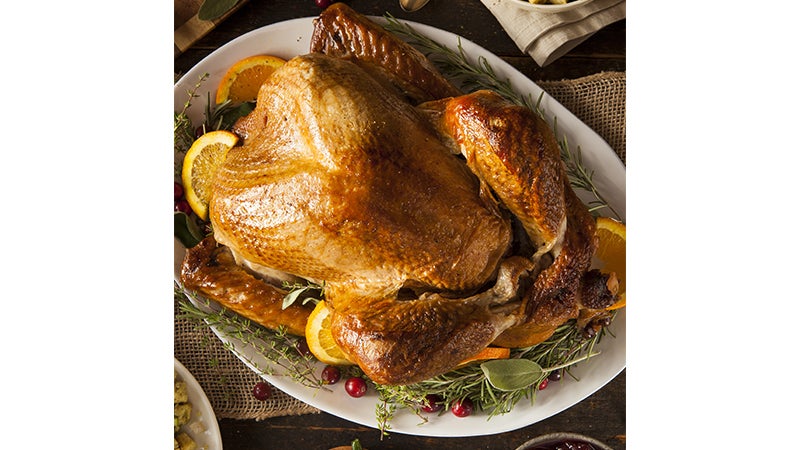Secrets to the best holiday turkey
Published 4:30 pm Thursday, December 7, 2017
There are literally hundreds of ways to cook a turkey and each year new recipes and techniques are created based on trendy regional ingredients and creative cooking methods. Some are good, some are bad, and some are downright unsafe. All are designed to tantalize the senses and produce the perfect turkey – moist breast meat, tender legs and thighs, golden brown skin and memorable flavor.
The greatest challenge for new and experienced cooks alike is to avoid the dreaded “dry turkey,” which is usually in reference to the white meat of the turkey breast. Because the flavor of turkey marries well with a host of ingredients, turkey can be successfully braised, roasted, grilled, fried, boiled, broiled, barbecued and so on.
Believe it or not, cooking a turkey is not that difficult. Which turkey cooking method chosen is up to the cook, just make sure it is a safe method. Cooking the turkey to the right doneness without loss of moisture takes a thermometer and digital ones are the better choice.
Believe it or not, do not wash the turkey. Bacteria in a sink is more dangerous than the turkey. If cooked properly the heat will kill the bacteria on the turkey. Wash hands, utensils, sink and anything else that has come in contact with the raw turkey with hot, soapy water immediately following preparation.
Marinating is a soaking technique, which enhances the flavor and tenderness of meat. Since commercial turkeys are young (four to six months) and tender, the mission of this marinade is to spread flavor throughout the bird.•
Jimmi Buell, Extension Agent, Family and Consumer Sciences, Polk County Center of the NC Cooperative Extension Service, teaches cooking and nutrition classes with a focus on improving health with better food choices. She can be reached at jimmi_buell@ncsu.edu or 828-894-8218.
Spiced Apple Cider Brined Turkey
One of my favorite recipes for creating a moist turkey
is the Spiced Apple Cider Brined marinate:
Ingredients
4 cups water
1/2 cup kosher salt
1/2 cup sugar
3 whole cloves
1 teaspoon black peppercorns, cracked
2 bay leaves, broken into pieces
4 slices fresh ginger
1 teaspoon whole allspice, crushed
1/2 gallon unsweetened apple cider, chilled (8 cups)
Turkey, 12 to 14 pounds, fresh or completely thawed
(With no injections or pre-basting)
2 turkey size oven cooking bags or large plastic tub
1 cup each chopped, celery, onions, carrots
Zest of one lemon or orange
Olive oil or butter
Directions
1. Use a mortar and pestle or spice grinder to crush whole peppercorns and allspice. Do not grind to a powder; large pieces should remain. In a 4-quart saucepan combine water, kosher salt, sugar, cloves, peppercorns, bay leaves and ginger. Stir as you bring the mixture to a boil over medium high heat. Boil gently for 2 minutes. Remove from heat.
2. Add chilled apple cider. Stir to combine. Refrigerate brine while preparing the turkey.
3. Remove turkey from wrapper. Remove giblets and neck from body cavity and neck area. Refrigerate these parts for stock for making gravy, later.
4. Rinse turkey inside and out under cold running water. Twist wing tips and tuck behind turkey. Place two plastic oven cooking bags, one inside the other. Set the bags in a large stockpot or roasting pan. Or use a large plastic tub, bags not needed. Roll top of bags over for ease in handling. Place the turkey, breast first, inside the double thickness of bags. Do not use trash bags or any bag that is not food safe (chemicals from bag will leach into turkey).
5. Pour chilled brine into turkey cavity and around outside of turkey. Pour an additional two cups cold water around turkey. Secure bag with twist tie. If using a roasting pan, turn turkey breast down. Rotate turkey four times during brining so brine reaches all parts. If using a stockpot the brine should cover the turkey, rotation is not needed. Refrigerate turkey for 12-14 hours.
6. Remove turkey from brine. Rinse under cold running water. Rinse well inside and out. Pat skin dry with towels.
7. Place turkey on a platter and refrigerate for several hours or overnight. This will allow the skin to dry. The skin will be very crisp with this drying step, however this step can be omitted. Turkey skin will still brown, but it will be less crispy.
8. Preheat oven to 350 F. Transfer turkey to a heavy roasting pan. Stuff the bird with chopped vegetables and zest. Position meat thermometer in thickest part of thigh. Tie legs together and tuck wings underneath the bird.
9. Cover the skin with softened butter or olive oil. Add 1 cup water to bottom of pan and place turkey in hot oven. Cooking time will vary depending on the size of the turkey. Check the wrapper and cook according to weight. Roast turkey until temperature in the innermost part of the thigh reaches 165°F or higher. A 12-pound turkey will take about 3 hours and 15 minutes to roast. Add 15 minutes for each additional pound.
11. The turkey is done when the thermometer reaches 165°F or higher. Using an instant read thermometer, check the temperature in the thickest part of the breast and the wing. The internal temperature for all areas should be 165°F or higher. Use of an instant read thermometer is the best method to check for doneness in all three areas of the turkey. Poultry is safe to eat at 165°F. Allow the bird to rest 20 to 30 minutes before carving. This will allow the juices to redistribute evenly through the meat. Reserve pan juices for use in gravy, dressing, etc. Store leftover turkey in the refrigerator or freezer promptly after the meal.






